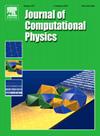Energy-conserving Particle-In-Cell scheme based on Galerkin methods with sparse grids
IF 3.8
2区 物理与天体物理
Q2 COMPUTER SCIENCE, INTERDISCIPLINARY APPLICATIONS
引用次数: 0
Abstract
Sparse grid reconstructions have recently been applied to Particle-In-Cell (PIC) methods with a semi-implicit formulation, as demonstrated in [28], to reduce computational costs. By linearizing the particle equations and using a finite difference discretization of the field's equations, along with incorporating sparse grid reconstructions through the combination technique, an exactly energy-conserving scheme was proposed. However, this scheme exhibited numerical instability due to the loss of non-negativity in electric energy, inherent to the combination technique. This paper introduces a novel PIC method with a semi-implicit formulation that embeds sparse grid techniques to exactly conserve discrete total energy, defined as the sum of non-negative kinetic and field energies, ensuring nonlinear stability. The method utilizes a Galerkin approach for the field equations, employing a hierarchical sparse grid representation in the approximation space. This distinguishes it from previous sparse grid PIC methods, which typically use the combination technique and nodal representation. The enhancement of hierarchical subspaces, serving as the truncated combination technique counterpart of the newly introduced method, is proposed to address the limitations of sparse-PIC methods— notably the difficulty in capturing non-smooth and non-axis-aligned solutions. Key features of the method include: unconditional stability with respect to the plasma period; mitigation of grid heating, allowing flexible grid discretization irrespective of the Debye length; exact conservation of discrete total energy; significant reduction in statistical error compared to standard grid schemes for the same number of particles; and decreased computational complexity, particularly in the size of the linear system to be solved. We validate the method through a series of two-dimensional test cases, demonstrating its numerical stability and robust performance.
求助全文
约1分钟内获得全文
求助全文
来源期刊

Journal of Computational Physics
物理-计算机:跨学科应用
CiteScore
7.60
自引率
14.60%
发文量
763
审稿时长
5.8 months
期刊介绍:
Journal of Computational Physics thoroughly treats the computational aspects of physical problems, presenting techniques for the numerical solution of mathematical equations arising in all areas of physics. The journal seeks to emphasize methods that cross disciplinary boundaries.
The Journal of Computational Physics also publishes short notes of 4 pages or less (including figures, tables, and references but excluding title pages). Letters to the Editor commenting on articles already published in this Journal will also be considered. Neither notes nor letters should have an abstract.
 求助内容:
求助内容: 应助结果提醒方式:
应助结果提醒方式:


